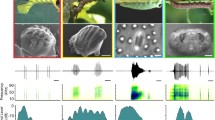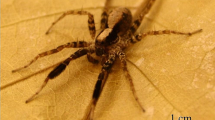Abstract
The response of bleak (Alburnus alburnus (L.)) to alarm substance (from skin extract of conspecifics) was quantified, using a video camera, in laboratory experiments across two light and one dark periods (18 hrs). In the light alarm substance induced hiding in refuges (vegetation) and formation of aggregations. There was no such reaction during darkness or during a second light period.
Similar content being viewed by others
References
Bold, E., 1980. Dial pattern of pelagic distribution and feeding in planktivorous fish. Oecologia 44: 368–375.
Dobler, E., 1977. Correlation between the feeding time of the pike (Esox lucius) and the dispersion of a school of Leucaspius delineatus. Oecologia 27: 93–96.
Frisch, K. von, 1941. Uber einen Schreckstoff der Fischhaut und seine biologische Bedeutung. Z. vgl. Physiol. 29: 321–333.
Garcia, C., Rolan-Alvarez, E. & L. Sanchez, 1992. Alarm reaction and alert state in Gambusia affinis (Pisces, Poecillidae) in response to chemical stimuli from injured conspecifics. J. Ethol. 10: 41–46.
He, Xi. & A. Wright, 1992. An experimental study of piscivoreplanktivore interactions: population and community responses to predation. Can. J. Fish aquat. Sci. 49: 1176–1183.
Jachner, A., 1995. Chemically-induced habitat shift in bleak (Alburnus alburnus (L.)). Arch. Hydrobiol. 133: 71–79.
Magurran, A. E., 1986. Predator inspection behaviour in the European minnow (Phoxinus phoxinus). Ethology 82: 216–223.
Magurran, A. E., 1990. The adaptive significance of schooling as an anti-predator defense in fish. Ann. Zool. fennici 27: 51–66.
Magurran, A. E. & T. J. Pitcher, 1987. Provenance, shoal size and the sociobiology in predator-evasion behaviour in minnow shoals. Proc. r. Soc. Lond. B 229: 439–465.
Pettersson, L. B. & C. Bronmark, 1993. Trading off safety against food: state dependent habitat choice and foraging in crucian carp. Oecologia 95: 353–357.
Pfeiffer, W., 1974. Pheromones in fish and amphibia. In M. C. Birch (ed.), Pheromones, North Holland Publishing Company, Amsterdam, London, 269–296.
Pfeiffer, W., 1977. The distribution of fright reaction and alarm substance cells in fishes. Copeia 1977: 653–665.
Pfeiffer, W., 1982. Chemical signals in communication. In T. J. Hara (ed.), Chemoreception in fishes, Elsevier, Amsterdam, 307–325.
Pfeiffer, W., G. Riegelbauer, G. Meier & B. Scheibler, 1985. Effect of hypoxantine-3(N)-oxide and hypoxantine-1(N)-oxide on central nervous excitation of the black tetra Gymnocorymbus ternetzi (Characidae, Ostariophysi, Pisces) indicated by dorsal light response. J. Chem, Ecol. 11: 507–524.
Pitcher, T. J., 1983. Heuristic definitions of shoaling behaviour. Anim. Behav. 31: 611–613.
Pitcher, T. J., 1986. Function of schooling behaviour. In T. J. Pitcher (ed.), The behaviour of teleost fishes, London, Croom Helm, 294–337.
Reed, J. R., 1969. Alarm substance and fright reaction in fishes. Trans. am. Fish Soc. 4: 664–668.
Seghers, B. H., 1974. Schooling behaviour in the guppy (Poecilla reticulata): an evolutionary response to predation. Evolution 28: 486–489.
Smith, R. J. F., 1992. Alarm signals in fishes. Rev. Fish Biol. Fish. 2: 33–63.
Smith, R. J. F. & A. D. Lemly, 1986. Survival of fathead minnows after injury by predators and its possible role in the evolution of alarm signals. Envir. Biol. Fish. 15: 147–149.
Sokal, R. R. & F. J. Rohlf, 1981. Biometry. 2nd edn. San Francisco, W. H. Freeman.
Sullivan, J. F. & G. J. Atchison, 1978. Predator-prey behavior of fathead minnows, Pimephales promelas, and large mouth bass, Micropterus salmoides, in a model ecosystem. J. Fish Biol. 13: 249–253.
Verheijen, F. J. & J. H. Reuter, 1969. The effect of alarm substance on predation among cyprinids. Anim. Behav. 17: 551–554.
Waldman, B., 1982. Quantitive and developmental analysis of the alarm reaction in the zebra danio Brachydanio rerio. Copeia 1982: 1–9.
Author information
Authors and Affiliations
Rights and permissions
About this article
Cite this article
Jachner, A. Alarm reaction in bleak (Alburnus alburnus (L.), Cyprinidae) in response to chemical stimuli from injured conspecifics. Hydrobiologia 325, 151–155 (1996). https://doi.org/10.1007/BF00028275
Received:
Revised:
Accepted:
Issue Date:
DOI: https://doi.org/10.1007/BF00028275




